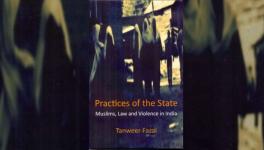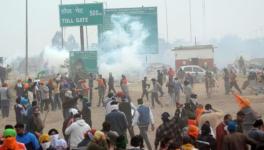Relook at a Book: Sophia by Anita Anand
Sophia is the debut book of Anita Anand, a radio and television journalist with BBC. It begins with a dedication from Florence Macaulay's 1909 poem- 'The Women's Marseillaise' -Arise! Ye daughters of a land/That vaunts its liberty! /May restless rulers understand/ That women must be free.
The book is spread over 21 chapters in three parts. After a Prologue, the first part of the book, Sophia's Childhood and History, 1876-1898, is divided into seven chapters, beginning with Roots of Rebellion. Part II is The Revolutionary Years-1898-1914 in eleven chapters and forms the core of the book. Part III-War and Peace, 1914-1948, has three chapters. Then follow an Epilogue, Notes, Bibliography, Acknowledgments, and Image section containing many rare photographs and a brief note on the author.
Anand got laurels for her first book, which led to her getting to co-author the second book Kohinoor with the well-known historian of the sub-continent, William Dalrymple. The book got reviews in all major international dailies and journals. Then she wrote The Patient Assassin, based on the life of Udham Singh, which also got her recognition as a biography author. Her background as a radio and TV journalist has helped her write biographies. Her family background from Sikh parents with Amritsar background and her ancestors having suffered during the Jallianwala Bagh massacres has made her a keen student of these Punjab personalities.
SOPHIA'S CHILDHOOD AND PUNJAB'S HISTORY
She begins her Prologue with the famous Suffragette protest at Westminster on Friday, November 18, 1910, with 38 specially chosen suffragettes sitting behind Emmeline Pankhurst, her firebrand daughter Christabel, the 74-year-old Doctor Elizabeth Garrett Anderson (England's first female surgeon, Mayor and Magistrate), in the meeting at Caxton Hall. Among them is Princess Sophia Duleep Singh, goddaughter to Queen Victoria and granddaughter of Maharaja Ranjit Singh. Five-foot-tall, she was usually the smallest person. She remained under the British government's surveillance since childhood due to her father, Duleep Singh's exploits.
In her first chapter, Anand narrates the birth of the princess in 1876 on August 8. Queen Victoria had spent fifteen years in purdah mourning the death of her husband, Albert, and Sophia's birth coincided with Victoria's return to life. She agreed to be the godmother of Sophia. Queen Victoria was bestowed the title-‘Empress of India'. She wore the Kohinoor, the legacy of Sophia's grandfather Maharaja Ranjit Singh whose wealthy kingdom had spread from Tibet borders in the East to Khyber Pass in the west.
In his 50-year rule, Ranjit Singh managed to unite Hindus, Sikhs and Muslims under one banner and brought unprecedented prosperity.
Anand traces the history from the iron age king Kuru through the legendary Mahabharat, invasions by Persians, the Mauryan, Kushans, Guptas, Hunan and Pala's reigns, Genghis Khan's plunder of Punjab down to the Lodis, and finally Sikhism. Ranjit Singh was born in 1780. At the age of just 19 years, he united all Sikh sects and became the founder of Sikh rule for the next 50 years before the British annexed Punjab in 1849, much later than the rest of India. She describes Ranjit Singh's rule, wisdom and liberalism. He died at 59 on June 27, 1839, and at his funeral on June 28, four out of his 20 wives and seven concubines burnt themselves alive (Sati) with the funeral pyre of Maharaja, though Sati is against Sikh tenets. Showing a rebellious spirit, one of the wives, Maharani Jind Kaur, refused and declared that she owed a greater duty to her only son. She had given birth to Duleep Singh on September 6, 1838, just 10 months before Maharaja died.
Maharaja had seven sons from her four older queens. Though outwardly existing peacefully, all were plotting against each other. After Ranjit Singh's death, one by one, his family schemed to kill each other. Violent assassinations went on till the last heir fell prey. The bloodshed was to haunt Duleep Singh forever. In 1843, Jindan's child of five years, Duleep Singh, was crowned as the last king, while 23 years old steely Jindan became regent. She was an independent ruler though controversial. The East India Company saw an opportunity, followed by three Anglo-Sikh wars.
In August 1847, Jindan was torn from the nine-year-old king's side and imprisoned in the Lahore fort. No Sikh general came to her support. At eleven, Duleep Singh resigned as king and Punjab were formally annexed in 1849. Duleep Singh was taken to Fatehgarh in UP under the care of John Login and his wife, Lena. He was converted to Christianity with Baptism at the age of 14 years during Lord Dalhousie's regime. Queen Victoria in England was fascinated by Duleep Singh, who was permitted to visit England. Duleep Singh went along with the Login couple to London, where he became a favourite of Victoria.
With the help of Logins, Victoria found a way of showing Kohinoor to Duleep Singh and getting it back from his hand as a gift to the Queen. On his 16th birthday, Duleep Singh was sanctioned 25,000 pounds in annual income. Duleep Singh had numerous liaisons with women, but none from the elite was ready to marry him. The author notes that in the 1857 Indian rebellion, the total loss of British killed was around 1500 only. In contrast, in revenge, thousands of Indian men were slaughtered, 20,000 or more in Kanpur itself, although some estimates put the number in lakhs.
In 1860, at the age of 21 years, Duleep Singh was allowed to meet his then-blind mother at a hotel in Calcutta. Mother and son grew very close. Jindan would narrate tales of the Sikh kingdom to her son, which he lost to the British. She died in London at the age of just 46 years on August 1, 1863. Duleep Singh was 25 then, two months later, his guardian John Login passed away. Duleep Singh was heartbroken.
On his way back to England after his mother's cremation, Duleep Singh chose to marry sixteen-year-old Bamba Muller in Egypt on June 9, 1864. The couple had six children-Victor-1866, Frederick-1868, Bamba-1869, Catherine -1871, Sophia on August 8, 1876, and Edward or Eddie in 1879. Duleep Singh was becoming extravagant in expenses; complaints were made to Queen. Blunt warnings were given by British officials. Duleep Singh-Bamba marriage was a sham for Bamba because of his gambling habit, his affairs with other women, and his children born out of marriage, with a few even carrying the Singh name. Duleep Singh was trapped in debt, but the British government offered no help, only loans with stringent conditions.
Victoria did not help. Duleep Singh did not attend the royal court for two years in anger. He wrote a book, The Annexation of Punjab, with Major Evans Bell targeting Dalhousie. He auctioned jewellery, became inimical to Raj, angry at snatching off his kingdom, and had a bitter exchange with Victoria, who had lost her son lately. He sold many things from his palace to sail for India. A cousin, Thakur Singh Sandhawalia, declared Maharaja Duleep Singh's return to the Sikh faith. He asked for forgiveness from Khalsa panth for leaving the faith. He asked for forgiveness from Queen Victoria for quitting England after three decades. On May 25, 1886, the pahul or baptism of Duleep Singh to Sikhism took place in the presence of Panj Pyaras and a granthi at Aden. Queen Victoria helped Bamba and her children in London. Arthur Oliphant, taking care of Duleep Singh's other children, told British officials that Duleep Singh was a "traitorous and dangerous lunatic."
Anand depicts the impact of Industrialisation in England. One million population of London in 1800 surged to six million in 1900. Dirt and drains, diseases like cholera, typhus, and influenza took over cities. In 1887, Sophia had typhoid fever. Bamba dismissed servants and took care of her daughter herself but died on September 18 morning. Duleep Singh did not come for the funeral, as he was in Russia with six-month-pregnant Marini Ada in the shabby guest house of Moscow. Sophia shattered, completely withdrew, and got just 2000 pounds of her mother's balance. Oliphant continued to care for sixteen-year-old Catherine, 18-year-old Bamba, 11- and eight-year-old Sophia & Eddie.
After Duleep Singh's death on October 21, 1893, five girls, Bamba, Catherine, Sophia, Pauline and Irene (from Ada), were given about 22,000 pounds each, with the two elder ones to get ten thousand pounds on marriage. Sophia and her sisters were granted grace and favour at Hampton Courts to be residents. They were called Princesses but not highnesses. On May 8, 1895, Sophia went through the ceremony of presenting before Queen mother.
Part-II- The Revolutionary Years-1898-1914
This is the main part of the book.
Sophia Became a great icon of cycling. She was passionate about her bicycle; she got fresh air, exercise, solitude and freedom. In her 20s, she took to smoking also, despised by Catherine and Bamba. She got five dogs as well. The timid girl became known for high fashion and dog breeding. She pursued her father's two more passions-music with piano and photography.
In post-Victorian England National Union of Women's Suffrage Societies came up. Bamba's medical course was cancelled in Chicago, making Sophia interested in women's suffrage. Curzon, Viceroy of India, planned Delhi Durbar for the coronation of Edward VII as Emperor of India. The sisters were allowed to travel to India. The author refers that between 1896 and 1902, 19 million people died in India due to famine. In India, the Bal-Lal-Pal trio were radicalising people. King Edward refused to travel to India and deputed his younger brother Duke of Connaught, for it.
Princesses travelled to India using aliases. Rehearsal for Durbar was held on December 29, 1902; Durbar was scheduled on January 1, 1903. During eight days of festivities, sisters were not invited to any function. They made their way to Lahore. Despite their low-key manner, people were excited to have Ranjit Singh's granddaughters in Lahore, memories of Jindan being dragged, and their father being thrown out of the kingdom. Lahore had a new statue of her godmother Victoria. Three sisters were shunned by British officers. The first one to take them under protection was a distant relative of their father-Gurcharn Singh. Harnam Singh, the uncle of Kapurthala Maharaja Jagatjit, also opened his doors. All three were fond of Umrao Singh Shergill, an elder of the Majitha clan. His wife, Narinder Kumari, was a Theosophist. Sophia rode on horseback to get a feel of the former Sikh empire. But her sisters suffered due to the heat of Lahore. Catherine and Bamba moved to Shimla, while Sophia stayed in Lahore to be with people in Punjab. On return, they found Sophia to be quiet at home. She made friends with Boota Singh and Kedar Natu, who taught them the language.
Lascars from India and China recruited by the East India Company, who were mistreated, and starved on inferior rations, were fighting to survive on the cold streets of London. Sophia was vaguely aware of lascars' plight; her father had provided funds to build a house for 'Oriental Seamen'. Emmeline Pankhurst realised that without women's vote, they couldn't help; she became a leading light of the Women's franchise league and supported the newly formed Independent Labour party. On October 10, 1903, a militant organisation- 'The Women's Society for Social and Political Union (WSPU) - was formed by a small group of women, including Emmeline and her daughters Christabel, Sylvia and Adela.
February 16, 1907, was a day of civil unrest in Lahore; students clashed with police. That night Gopal Krishan Gokhale was to speak in the main lecture theatre of Lahore. Sophia and Bamba were seated on specially reserved seats. Gokhale asked the audience to pay respects to Maharaja Ranjit Singh's granddaughters, which overwhelmed the sisters. The next night, Lala Lajpat Rai was to speak. Both sisters were retaken to the dais despite protestation. Rai's speech entranced Sophia; he became Sophia's hero. Rai also paid them deference. Gokhale and Rai made an unexpected visit to their home to meet their sisters, who were completely unprepared for the visit; the house was a mess. The sisters travelled again to their grandfather's domain. They visited Jalandhar and Mamdot horse fair too. They later visited Nabha and took intense disliking for Hira Singh, the Maharaja, who said his uncle Ripudaman Singh foolishly rebelled against the British.
Plague has plagued Punjab; in April 1907 alone, more than three lakh people died. Sophia had spent six months and convinced Bamba to travel back to England. Sophia went to see and pay respects to her grandfather Maharaj Ranjit Singh Samadhi. Bamba wrote to Rai, and he came to see Sophia before she left Lahore. Sophia left Lahore on April 13, though her ship was to take off on May 5. On the ship, she got Bamba's letter informing Rai's arrest under sedition charges. Anand does not mention that Rai led peasants with Ajit Singh in those days, for which he was arrested. She picks and chooses in her way the historical events.
In London, Sophia kept track of Rai's news. The author has quoted England Parliament proceedings about Rai's arrest, who was released after six months without charges being brought against him. Again, there is no mention of Ajit Singh and his exile. Sophia came into contact with Una Dungdale, the daughter of a naval commander and headstrong suffragette. So, Sophia became both a nationalist and suffragette in 1907. By 1909, Sophia became involved in the Women's Suffrage movement. Gandhi visited England in 1906 from South Africa to repeal a black law against South Africans. Gandhi wrote about the suffrage movement in his paper Indian Opinion after his return to South Africa. British official involved with India, Curzon Wyllie, was shot dead on July 1, 1909, by 26-year-old Madan Lal Dhingra, who was tried and hanged on August 17, 1909.
In 1909 a new suffragette organisation Tax Resistance League was born-No taxation without Representation- Sophia signed up as a tax resister. Liberal candidate Churchill was thrashed with a dog whip by Therese Garnett as a suffragette n November 1909. On May 6, 1910, King Edward VII died, and Duleep Singh's family lost their last benefactor.
In support of the conciliation bill for voting rights to women, a women's march to Hyde Park by more than 20 thousand women gathered, with 150 prominent speakers booked for the event. March was organised from two sides-from the west; it was by the Women's Freedom League, and from the east, by WSPU. As Prime Minister Asquith returned to his word, on November 18, Emmeline led the march with other suffragettes, and Sophia was among the first to register. At 45 years, Churchill was the youngest home secretary. Sophia, at 34, was the youngest suffragette in Emeline Pankhurst's nine-woman strong vanguard. England's first woman doctor and first mayor, Elizabeth Garrett Anderson, at 74, walked with Emeline. The eldest suffragette in the group was Dorinda Nelligan, 77 years old headmistress. Women were treated with excessive brutality by police, and even Churchill was appalled. She was arrested with 115 women and four men but was not charged.
Lord Curzon, ex-Viceroy of India and Kitchener were two suffragette enemies. On February 6, 1911, WSPU chose to stage a coordinated protest-the day-that day Sophia jumped on Prime Minister Asquith's car, shouting suffragette slogans and throwing a banner; she was physically lifted out. That made the newspapers headlines-The Princess as Picket. Queen Victoria's goddaughter was not arrested, but Sophia again dared authorities to arrest her during the 1911 census by defying the count on April 2. Emma Lloyd was another committed suffragette, but she crossed paths with Emeline because of her autocratic style. Emma Sproson went on a hunger strike in jail and won the status of a political prisoner.
Emeline organised window smashing on March 1, 1912, and 120 women got arrested. Emily Davion became the first martyr of the suffragette cause in 1913. Sophia was fined twice; both times, she refused to pay and was prepared to go to jail, but someone else would pay. On January 6, Sophia's residence, Faraday house, was raided. Sophia was not only herself funding the women's suffragette movement; even her half-sister Pauline gave small funds. With the onset of the first world war in 1914, the suffragette movement was withdrawn by Emeline Pankhurst in favour of patriotism.
Part III- War and Peace-1914-48
This is the third and last part of this narrative. Sophia, during the war, was concerned about Catherine and wanted to get her back to England as England was at war with Germany. 40,000 Indians were deployed in the war in Europe. Indians wounded in the war were brought to England. In 1915, Sophia was tending to Punjabi soldiers in Lady Hardinge hospital. Punjabi soldiers were overwhelmed by being tended by Sophia; many got signed photographs with her. Now the Ghadar party narration enters.
Lala Har Dayal is mentioned in detail. By 1916, a million copies of their weekly journal were published and circulated worldwide. Sophia participated in fundraising for soldiers on September 20, 1918, in the form of flag day.
Victor, Sophia's elder brother, died of a heart attack in those very days. Catherine was finally allowed to return to England by the end of 1918.
In 1919, the British passed the Rowlett act, a draconian law. Now Gandhi's story of South Africa is woven into the narration, and later his Indian story from Champaran, although some facts seem incorrect. By the end of the war, Sophia in melancholy, Bamba married David Waters Sutherland, Principal at King Edward college in Lahore. In March 1920, Sophia wrote a humble letter to Mr Montagu for help. With Annie, Sarojini Naidu and other women, Sophia also pleaded for women's vote to British Govt. Bamba invited Sophia to Lahore in her desolation, and she took her helper Bosie also with her. Both sisters visited Nashik, where their grandmother Jindan was cremated. Harbans Singh, the grandson of Shyam Singh Attariwala, was the link between their kingdom's past. Both sisters travelled through their kingdom in Indian dress. Bosie was used to spy on princesses. Sisters visited the Amritsar Jallianwala Bagh site in 1924. They left for Kashmir in April. In 1923, Temples and mosques were burning all over India. Gangs f Sikh-Hindus bought battles with gangs of Muslims. Gandhi started fast at his friend Mohd Ali's house on September 17, 1924; Nehru wept at his bedside in the second week of the fast. After 21 days of peace, Gandhi broke the fast.
The suffragette movement got a boost as the People's equal franchise bill was finally passed in 1928 and got Royal assent. By that time, Asquith and Emmeline Pankhurst had both died. Emeline had turned rightist from a leftist. She died at 70 in June, before her dream came true. A statue of Emeline was unveiled on March 6, 1930. Bamba was considered short-tempered; now Sophia, resigned to being a spinster, had become fussy. On August 26, 1938, Lina Schaeffer, partner of Catherine, died at 79.
Catherine moved to England while Hitler was hegemonic in Germany. Hitler targeted London, so Sophia also moved out to Rathenrea with Catherine. Uninspiring life in Buckinghamshire, Sophia developed a soft spot for Michael, Shirley's brother, despite being a little terror. Sophia got attached to children. Walter de la Mare, the poet, was living in the neighbourhood. In 1942, with air bombings, Catherine passed away, and Sophia raved in grief. Now Sophia was attached to four-year-old Drovna, giving her the doll given to her by Queen Victoria as godmother. In 1945, with the end of the war, Sophia returned to London to see Hampton court was not harmed. To Drovna, she said, 'you are never ever not to vote.'
Sophia saw Indian independence and partition. Bamba came to England after the partition. Drovna was the daughter of Bosie, her helper. On August 22, 1948, Sophia died peacefully at 71. Sophia wished to be cremated as a Sikh, and her ashes were scattered in India.
EPILOGUE
At the age of 80, Bamba took the ashes of both Catherine and Sophia in 1949, coming by land to Lahore. She travelled to Germany and asked Catherine's ashes to be buried with Lina's. Bamba took residence at Hilda hill. There were quarrels, and Bamba was the executioner of her will-one will to fund one Hindu, one Sikh and one Muslim girls' school, some money for dogs' houses and animal welfare. Pecuniary bequests to people like Pritam Singh, artworks for Indian galleries. Greatest generosity to Bosie, Lane and Drovna, most for Drovna.
After bequeathing Sophia's will, Bamba sold everything in London and returned to Lahore to live out the rest of her life with Pir ji as her only company. She died in 1957 and was always called Queen of Punjab; her remains are buried in Lahore's Christian cemetery. Drovna remembered everything and met the author in 2012 to complete Sophia's story.
INTERESTING YET FLAWED BIOGRAPHY
Anand's The Patient Assassin induced an irritating feeling, and the same feeling came through this book also. The author has a good command of English and professional experience with media platforms but does not commit to either the subject of her writings or broader social concern. The subject matter is to be used for creating a racy narration without bothering even to facts. Though the author has consulted lots of archival material and met many related people to record their interviews, which has been used to create a racy interesting narration, the characters chosen for narration have been subjected to somewhat vilification. It is not just a realistic depiction of characters with all their weaknesses and flaws; instead, they have been overplayed to almost damn them. Both Duleep Singh and Udham Singh in both books don't inspire but are shown as living a reckless life without any deeper motivation. Sophia does earn a sympathetic chord in the reader's mind, yet she is just reduced to an ordinary princess.
This kind of history and most of these narratives are coming from Bloomsbury publication, which looks like History with chutney, to make it spicy and tastier, leaving aside serious parts of lessons to be learnt from history away. In a sense, it is a designed history to make it less serious, to enjoy like a novel-like narrative.
The writer retired as professor in Hindi translation from Centre of Indian Languages, JNU, New Delhi; was Dean, Faculty of Languages, at Panjab University, Chandigarh, and at present is honorary advisor at Bhagat Singh Archives and Resource Centre at Delhi Archives. The views are personal.
Get the latest reports & analysis with people's perspective on Protests, movements & deep analytical videos, discussions of the current affairs in your Telegram app. Subscribe to NewsClick's Telegram channel & get Real-Time updates on stories, as they get published on our website.
























